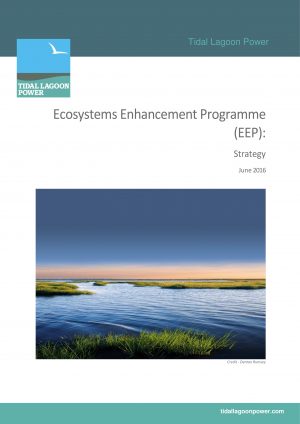Detailed feasibility and site selection work has started on a range of potential restoration and compensation measures under the Ecosystems Enhancement Programme (EEP) in order to protect nature for the future by enhancing habitats for species around the UK, working in partnership with leading local, national and international conservation organisations.
In order to meet UK and EU environmental obligations and compensate for both the direct and indirect effects of lagoon development, the EEP will restore and create wetland habitat at a hitherto unprecedented scale. Initial research commissioned by Tidal Lagoon Power (TLP) has identified around 109,000ha of coastal land in England and Wales that could be reinstated as coastal wetlands. High level prioritisation of these sites and subsequent consideration of a wide range of criteria has resulted in a shortlist totalling approximately 16,000ha. In investigating these opportunities in the context of Tidal Lagoon Cardiff (in the first instance), the EEP is adopting a hierarchy in terms of the location of compensatory habitat as follows: within the lagoon, adjacent to the lagoon, within the Severn Estuary, within or adjacent to the Bristol Channel, on the Welsh Coast, within other UK estuaries and coastal zones used by shorebird populations of the Severn Estuary and then to areas functionally linked within the Atlantic Biogeographical Zone. Negotiations with landowners, along with further, more detailed, investigation is ongoing at a number of these sites. Scheme design, EIA and planning applications will be taken forward in parallel with the development of the future fleet. EEP sites will aim to deliver multiple benefits not only for maximising biodiversity but that also offer initiatives relating to recreation, ecotourism, education and heritage, where appropriate.
The EEP will trial innovative methods to maintain, create or enhance intertidal habitat within lagoon environments. As part of these efforts, TLP is co-funding a PhD with Swansea University and Frog Environmental Ltd to test floating and fixed artificial reefs as biodiversity enhancements in the coastal zone. Applied research, such as this, will inform the range of measures that the EEP will integrate into the design and operation of tidal lagoons. The EEP also aims to deliver habitat restoration efforts for migratory and resident fish and birds, alongside targeted enhancement initiatives for relevant priority features and species, to support local and European-scale biodiversity conservation. This is likely to involve (amongst other things) defining, supporting and implementing upstream measures, for example, the removal of barriers to fish migration and working with land owners to change land management practices and enhance biodiversity by reinstating river meanders or margins for fish. Current opportunities being explored with a number of partners include catchment to coast based initiatives in areas such as the Rhymney River where enhancement schemes could offer the potential to regenerate, restore and reconnect the river and local communities, creating a haven for both people and wildlife.
